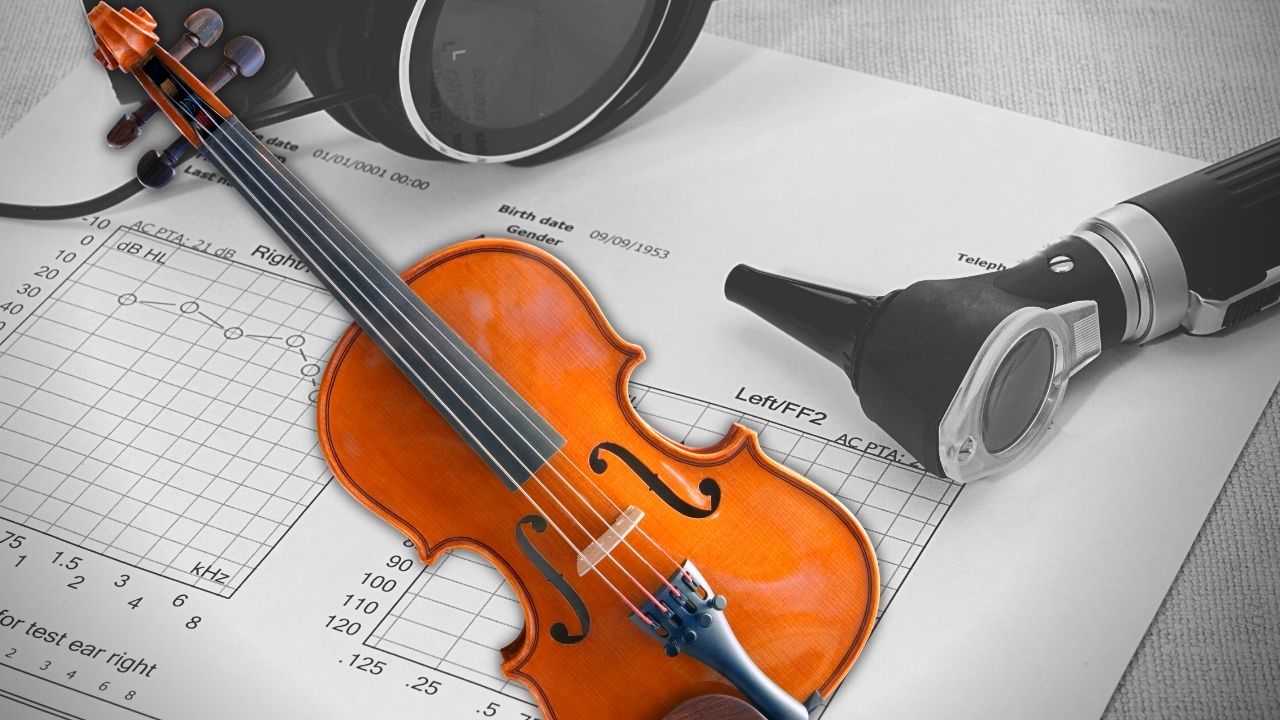Last week I saw a violinist with an 8000-Hz audiometric notch in her hearing test. This is not unheard of and I have observed this clinically before, especially with violin and also some piccolo players.
Textbooks in audiology are fond of stating that any long-term damage from noise (and music) exposure tends to be restricted to the 3000-6000 Hz region, which is around the top note on a piano keyboard. The reasons for this are varied, but all are poorly understood.
Reasons for Audiometric Notch
Essentially there are five possible explanations, and more than one of these may contribute to the finding of an audiometric notch in a certain frequency region.
- There may be a relatively poor blood supply to the part of the cochlea that corresponds to the region of 3000 to 6000 Hz.
- There may be a greater susceptibility to damage to the hair cells and supporting structures in this frequency region.
- The orientation of the stapes footplate into the cochlea is such that its primary force vector aims towards those hair cells in this region, with eventual failure due to hyromechanical action (i.e., the 8000-Hz and above region is in the lee of the hydromechanical “storm” that is set up in the cochlea).
- The area of hearing loss is greatest depending on the energy content of the offending noise/music spectrum.
- Permanent hearing loss from long-term noise/music exposure has its greatest effect approximately half an octave above the peak of the noise/music spectrum, which tends to be in the 3000-6000 Hz region.
Each of these possible explanations has a wealth of literature supporting it, especially the last three possibilities. It is not unusual to see a very large man with a 3000-Hz audiometric noise notch where his ear canal is so long that it resonates at 2400 Hz. One half octave above 2400 Hz is about 3500 Hz, and since only 3000 Hz and 4000 Hz are typically assessed, it is possible to obtain an audiogram with the poorest acuity around 3000 Hz. In contrast, I cannot remember ever seeing a relatively small person (with a shorter ear canal that resonates at close to 3000 Hz) having an audiometric notch at such a low frequency. Most musicians have a 6000-Hz audiometric notch rather than at 3000 Hz or at 4000 Hz. Many musicians are simply not as large as NFL football players or long-distance truckers.
Of course, the correlation between apparent physical stature and frequency location of an audiometric noise/music notch is nowhere close to 100%, yet there is some correlation.
What this may effectively mean is that those people with a shorter ear canal (and associated higher resonant peak) would have greater “amplification” of the environmental noise before it even reaches their cochlea, and this may result in a higher frequency audiometric notch than if this natural outer ear resonant frequency was lower.
The nature of the energy distribution in the offending noise/music spectrum – the fourth possible explanation stated above – has not been well investigated. In 1983 Mills and his colleagues performed a study that showed that for very low frequency (below 500 Hz), high-intensity stimuli, the greatest region of temporary threshold shift (TTS) would be in the 300-750 Hz region.
While it can be argued that TTS is not the same as permanent hearing loss (PTS), something is definitely happening in this low-frequency region that is noise/stimulus related.
Noise Exposure and Notches on the Audiogram
To date, there is little research to indicate treble musical instruments (or occupational noise environments) cause a reduction in hearing acuity that is greatest in the region above 6000 Hz, but given the Mills et al. (1983) data and the clinical occurrence of 8000-Hz notches with some violinists and piccolo players, there is some reason to investigate this “upper bound” of 6000 Hz for long-term noise/music exposure. This would make for an interesting Capstone essay for some intrepid AuD student.
One possible reason why this has not been widely reported in the literature is that a typical audiometric assessment only extends up to 8000 Hz, and unless 10,000- or 12,000-Hz hearing acuity is assessed, any dip in the 8000-Hz region may not be recognized as a notch, and may incorrectly be attributed to earphone placement, presbycusis, or the presence of cerumen in the ear canal.
Clinically I do test up to 12,000 Hz, especially with musicians. As shown by the work of Michael Stinson and his colleagues a test frequency of 12,000 Hz is just at the edge of suffering from calibration problems which are well-understood with high-frequency audiometry, but the variability is still good up to 12,000 Hz; the problems typically arise above 12,000 Hz.
Current research is limited in showing whether high-frequency musical instruments or occupational noise environments significantly affect hearing above 6000 Hz, despite some indications of 8000-Hz notches in violinists and piccolo players. This gap in the literature might stem from audiometric assessments typically reaching only 8000 Hz, potentially overlooking notches or attributing them to other factors; however, clinical testing up to 12,000 Hz, particularly for musicians, provides valuable insights despite potential calibration issues beyond that frequency range.
One can argue (and I would tend to do so) that testing at 10,000 Hz and 12,000 Hz is a waste of clinical time. It may help define an 8000-Hz audiometric notch, but other than being of academic interest, I see no clinical value in it.
I must admit that I do test these frequencies out of my personal academic curiosity, but I acknowledge that it will not alter what I will be able to offer the musician who has an audiometric notch at 8000 Hz as opposed to the more “conventional” 3000-6000-Hz region.






